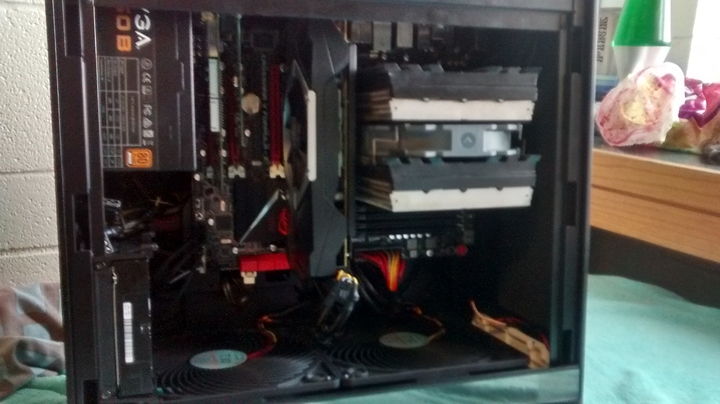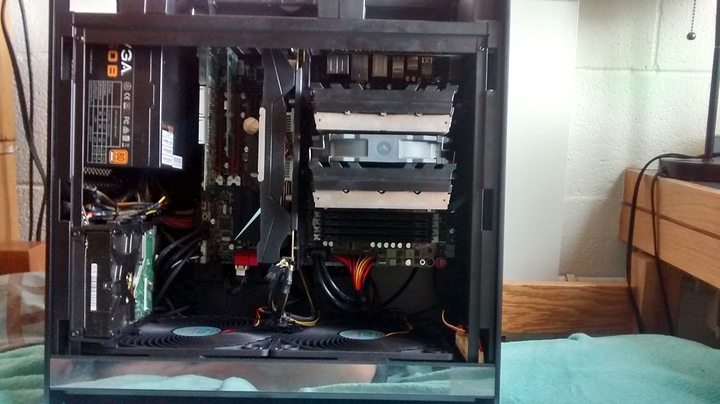I recently had the great pleasure of changing the case for my desktop. The case before this one was a Fractal Design Define R5 from around 2 years ago. I originally bought the case planning to upgrade to water cooling down the line, and my previous case, an Antec eleven hundred v2, had 0 water cooling support, but more on that later. I'll mostly be comparing to my R5, but I'll also include my thoughts compared to my original case. Sadly I wasn't able to get a lot of pictures of this one, but I'll see about posting some at some later point though, as there aren't many people with the FT05, and even fewer pictures of the case floating around.
Initial thoughts:
It came in the same kind of box with the same kind of packaging I've seen in every case I've ever had shipped to me, nothing special there. The case comes with relatively few accessories, which at first was somewhat frustrating for me, but realistically doesn't impact the performance of the case at all. A small screwdriver or tool for mounting the motherboard standoffs would have been nice. Dust filters are included for both the intake fans as well as the PSU, both magnetic and easy to reach, awesome possum.
One of my first thoughts after getting this case out and opening it up was "wow, this is pretty nice". This is the nicest quality case I've ever worked with, the only complaint I can make is the top cover and IO cover being plastic. However, I could see how the inclusion of a metal component at the top could be problematic, as it would probably get pretty hot after some time. Beyond that, the inclusion of a metal cover does nothing for the performance overall, and would probably result in a much higher price tag. A trade I'll make. But again, the build quality is fantastic, case is incredibly well build, solid, and looks fantastic.
Internals:
This is where this case gets really fun. The 90 degree rotation of the motherboard makes this case seem very foreign, even to an experienced builder like myself. Because of this there are some interesting points I want to not about the case. First, if you're looking to use a 3.5" drive, it is mounted underneath the PSU, effectively limiting the size of PSU you can use to 160mm. Also, there is very little room in this case for cable routing and management. There is an incredible lack of cable tie down points, as well as the fact that a huge amount of the case is exposed, making cable routing a bit of a challenge.
The centerpiece and highlight of this case are the dual AP-180 fans in the bottom. I knew these would be a main feature when I decided on this case, but how dominant and front and center they are really isn't apparent until the case is in front of you. Between those massive fans and the relatively small building space in the case it would be easy to mistake for a m-atx case. The case is obviously built around these fans and with their use in mind, they are aligned perfectly and look fantastic in the bottom.
Building:
Building in this case, oh man. I wish that I could say it was fun. It took hours, and even then the cable management and overall quality of everything is still ok at best. Due to a PSU dying on me a while ago, I was forced to use my non-modular backup PSU, which was a real disadvantage here. On multiple occasions I had to take one or two steps back, undo putting a part in, etc. The CPU power cable had to be per-routed, along with other problems. An extremely frustrating case to work in. Even with planning and a modular PSU, there is very little space behind the motherboard, so cable management will always be a chore.
The Finished Product!
Performance:
This makes all of the frustrations of building with this case worth it. The performance is amazing, like, blew me away impressive. With the case fans set to their lowest, and a single fan on my cooler (as opposed to both in the R5) my CPU temperatures have dropped 8-12c (spread is due to uncertainty in ambient, dorm fluctuates a lot), compared to my R5 with 2 gentle typhoon 2250 RPM at full tilt in the front and a Noctua nf-12 in the back as exhaust. GPU temperatures are also about 10c lower at about 10% slower fan speeds, which is important to note. A lot of people claim that this case really negatively impacts GPU cooling because of the way that heat pipes work, especially cards with "vertical" heat pipes. As best I can tell, my card definitely does have "vertical" heat pipes, and I still saw a noticeable performance bump, so all I can say in response to those claims and rumors is that they're false. I'm beyond happy with the temperatures on my GPU and CPU, and honestly I think I may well be able to push the old 8350 up to around 4.8 or 4.9 again, something I've not been able to pull since my Antec eleven hundred.
Noise is always a big concern for me. I sleep next to my computer both at home and at school, and beyond that I enjoy having a quiet computing experience. Most of the time I use speakers rather than headphones as well, so lower noise is always nice for that. This is by far and away the quietest case/system I have ever had, hands down. At the lowest setting the AP-180s are inaudible, and still manage to move enough air that the rest of the fans in the system dont need to ramp up. Couple that with the sound deadening foam, and the case is whisper quiet, while still offering incredible cooling performance as well as even more overhead for performance gains. Honestly, the noise and performance aspect of this case have blown me away. Even compared to the gold standard in quiet computing, the R5, this case manages to wipe the floor.
How it compares:
R5 - The case is much cooler than the R5, as one might be able to guess. It's comparing a case designed for high airflow cooling to one designed for quiet computing, so obviously we would expect to see the FT05 pull ahead in this department. The FT05 happens to also be the quieter overall case as well, given the large size and airflow of the case fans and their slow/quiet speeds. While with stock fans or slower, quieter fans the R5 would obviously be much closer, but for a hotter/older or higher performance pc the fans and speeds needed for adequate cooling on the R5 quickly gets louder than the FT05. In terms of ease of use, hands down the R5 wins, no contest. Building in the FT05 is just short of a nightmare. Compatibility/expandibility also goes to the R5, as the support for 5.25 bays, up to 8 3.5" drives, no limits on what power supply can be used, same air cooling compatibility, and actually supporting AIO or water cooling. While you can mount up to a 360mm radiator in the bottom of the FT05, you defeat the whole purpose of the case in doing so, effectively locking you in with air cooling, or a single 120mm radiator. With the R5 dual 360mm radiators can be installed, albeit with some modding. Stock the case can support up to a 420 on top and 280 in the front, far greater compatability in terms of water cooling. The R5 has great quality for the price, and is a solid case with solid features at a solid price. The FT05, on the other hand, costs a fair bit more and has the quality to justify that. Good quality sound foam on the inside, excellent aluminum construction, an interesting side panel mechanism not unlike the R5, the FT05 holds it's own and then some in the quality department.
Antec Eleven hundred V2 - It's been a while since I last used this case, however my core configuration has not changed much. Same CPU/Mobo/Cooler, currently with a 480 with a low end cooler instead of a 290 with a high end cooler. Also designed as a air cooling case, the Antec was a dated design, even back in 2013. Non removable drive cage, non removable 5.25 bays, limited fan mounting options (2 120 in front, 200 in the top, 120 in the back) all hurt the case. I ran the case with 2 120mm at full speed in the front intake, with another 120 mounted to the inside of the HDD cages (an interesting feature) to further blow the air across the GPU. The case almost always ran at a negative pressure, as a result of the massive 200mm fan up top, which did probable help with temperatures. However, compared to the FT05, the case was larger, louder, hotter, and equally restrictive in terms of expansion, if you disregard the HDD situation. While temperatures were better than my R5, the noise was far louder in terms of the performance it gained me. The build quality of the Eleven hundred was below both of the other 2 cases, and overall the case itself felt less thought out, more dated, and more of a dead end than either the FT05 or R5.
At the beginning of this whole thing I mentioned water cooling support, that was a driving force behind me wanting to upgrade my case from the Antec to the Fractal. I was really interested in getting an AIO at the very least, as well as upgrading to a custom loop. Well, 2 years later and there's still no custom loop, and no plans for one, I'd much rather upgrade and build other things with my money, so i decided that instead of optimizing airflow in a case not designed with that in mind I would change things up, hence the FT05. Now, I'm basically committed to air cooling, but I think that's ok. I'm fine with that, and I know that if the time comes that I'm committed to doing a custom loop or that I'd like to move to water cooling that I can always change cases again, but as far as I'm concerned, this case is exactly what I needed and more. Never would I have guessed that this high of performance could be so quiet. I'm beyond thrilled, kudos to Silverstone for such an excellent product. More people, especially experienced guys really should take a look at the Fortress and Raven series, the cooling is wicked, and the noise savings because of how low you can run the fans is great too.
I'll happily field any questions about any of the cases or the hardware that's run through them, let me know what you guys think!

